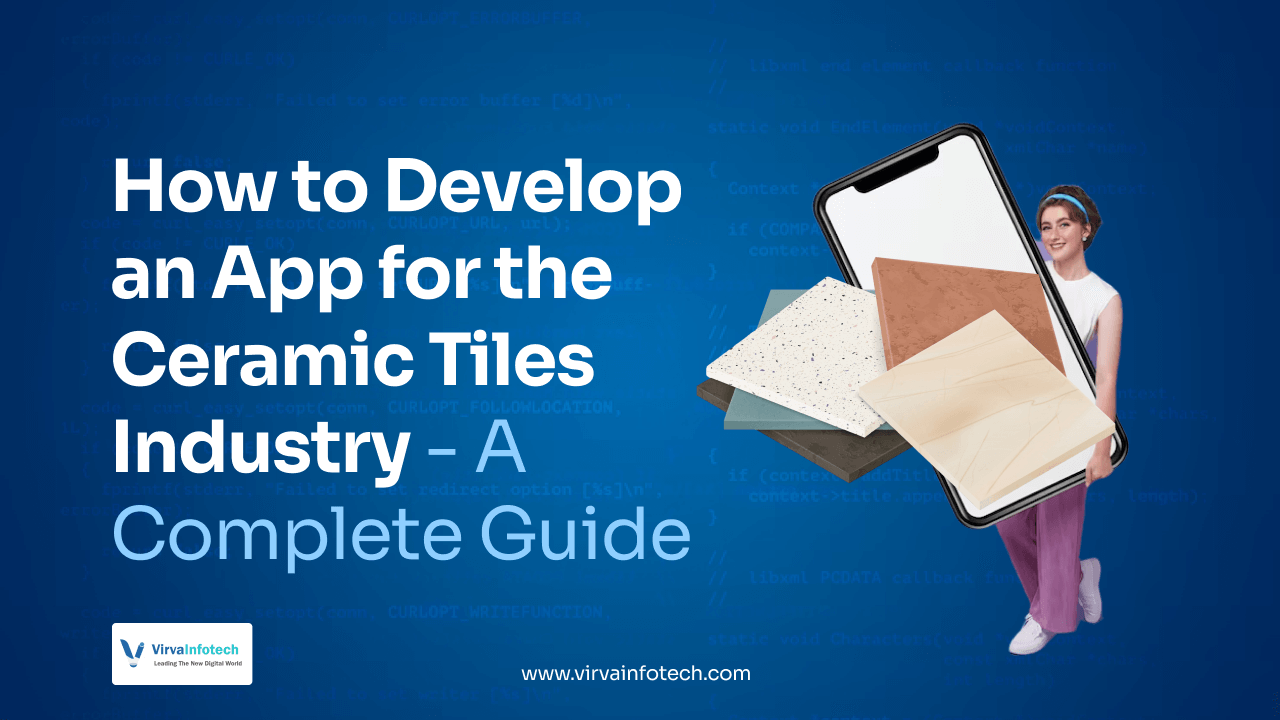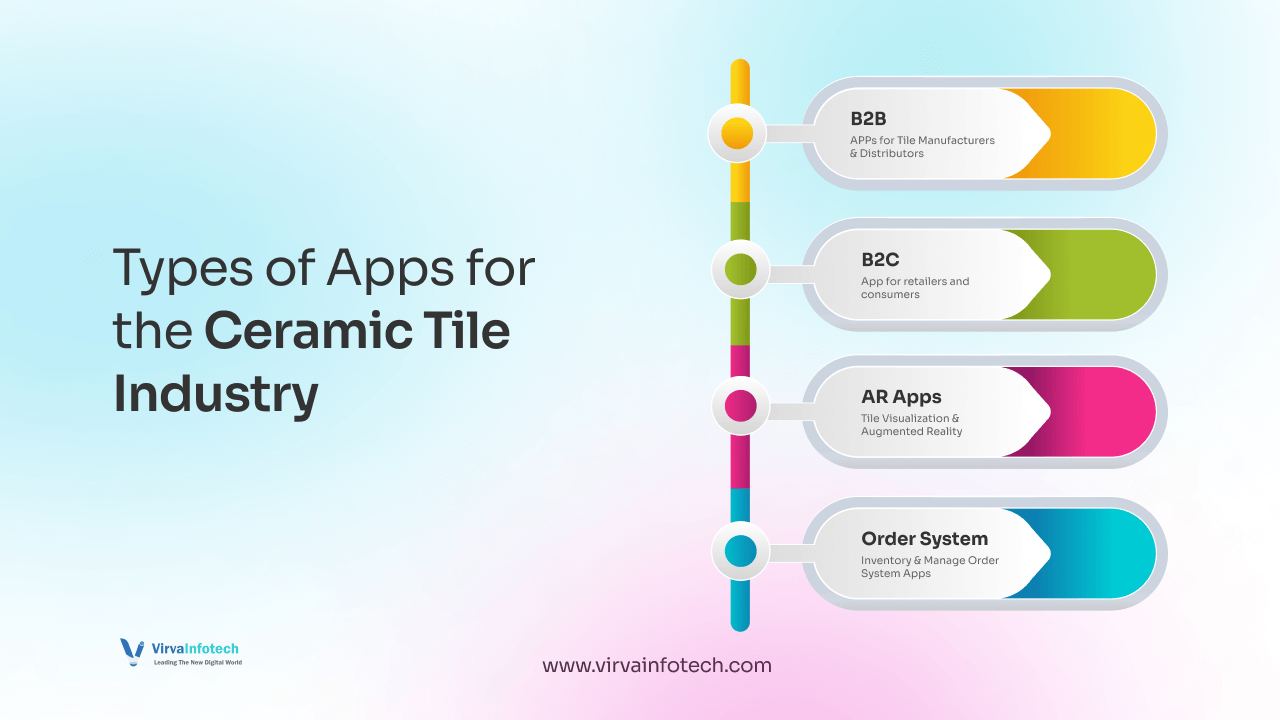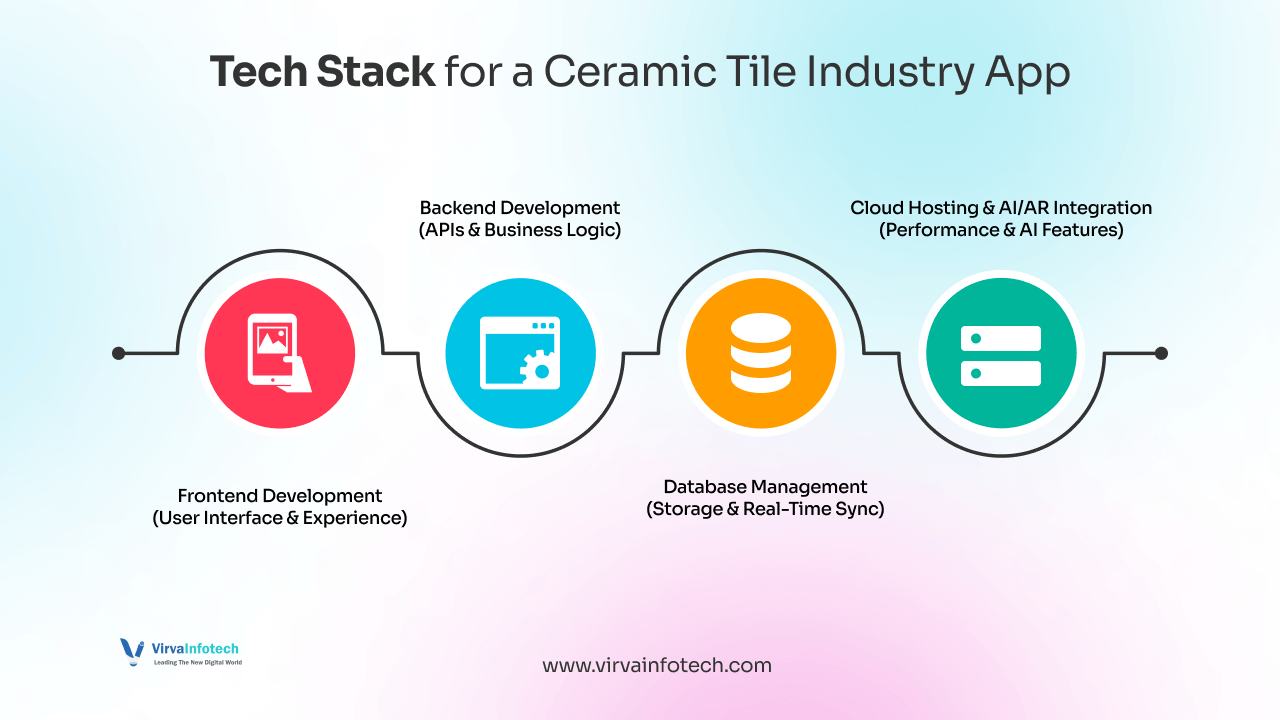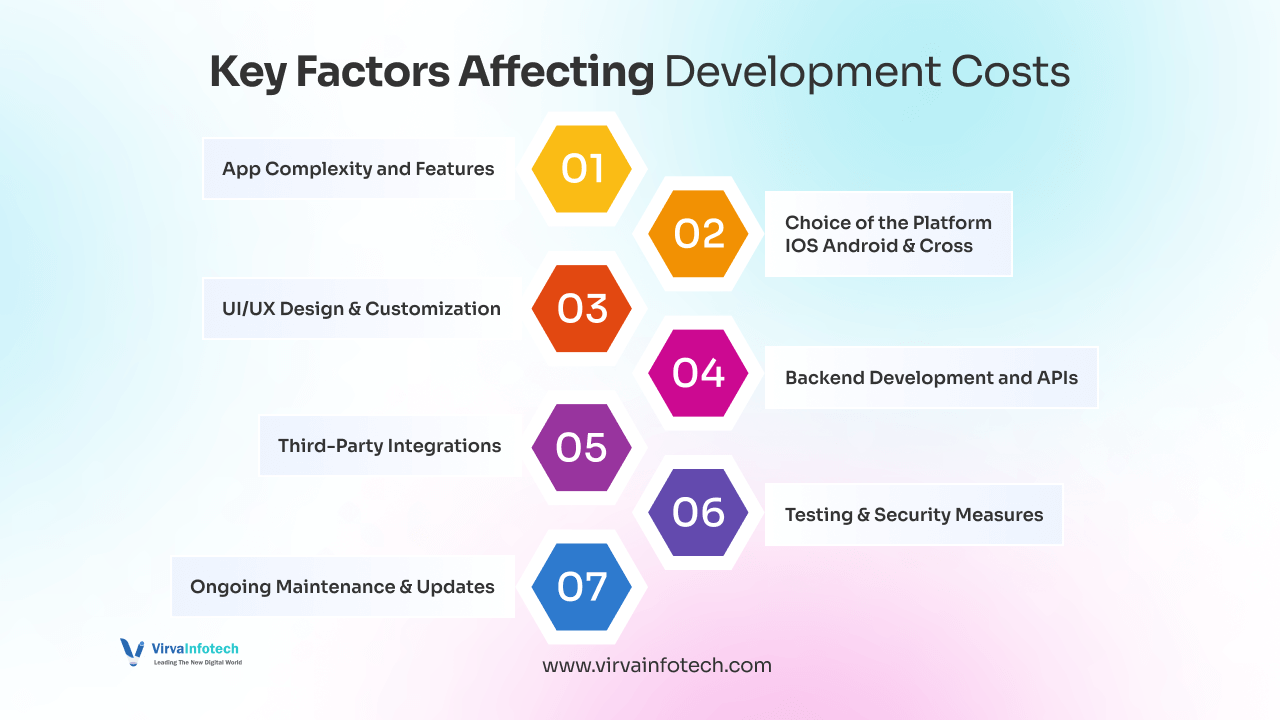Posted At: Mar 25, 2025 - 36 Views

Introduction
The ceramic tiles industry has seen rapid digital transformation, with businesses increasingly relying on mobile apps to enhance customer experience, streamline operations, and boost sales. From tile manufacturers and distributors to retailers and customers, an app can serve as a one-stop solution for everything related to ceramic tiles.
In this guide, we’ll explore how to develop a ceramic tiles app, key features to include, the best tech stack, monetization strategies, and cost estimations.
Types of Apps for the Ceramic Tile Industry

1. B2B APPs for Tile Manufacturers & Distributors
B2B applications are very important for tile manufacturers, wholesalers, and distributors to successfully manage their supply chain, inventory, and order processing. Such apps are intermediary between manufacturers and bulk buyers, facilitating transaction and logistics management.
Key features:
Inventory management: Allows manufacturers to track the flow of raw materials and manufactured products.
Order tracking: Distributors can track bulk orders in real-time.
Supplier communication: Allows seamless coordination between manufacturers, suppliers, and logistic providers.
Automated Invoicing: Generates digital invoices and purchase orders, allowing for faster transactions.
Data analytics and reporting: Provides sales reports, demand forecasting, and business insights.
Benefits:
✅ Diminishes operational inefficiencies and delays.
✅ Automates stock replenishment and purchase orders.
✅ Improves collaboration among manufacturers and distributors.
(2) B2C app for retailers and consumers
Business-to-consumer applications help retailers sell tiles directly to customers through a very interactive shopping experience over the Internet. These apps have been basically modelled on virtual stores where customers can browse the collections of tiles, compare the prices, and place orders without having to go to a physical showroom.
Key Features:
Product Catalogs with High-Quality Images: Shows tile designs, colours, sizes, and finishes.
Real-Time Stock Updates: This makes sure that customers see only those products that are.
Online Ordering and Payment Integration: This Absorbs all the payments like credit or debit card payments, UPI payments, or other digital wallet transactions.
Customer Reviews & Ratings: It makes an informed buying decision.
Personalized recommendation: AI identifies what others would be able to suggest.
Benefits:
✅ Increases sales via a smooth shopping experience.
✅ Reduction in dependency on physical showrooms.
✅ Greater visibility and customer engagement with brands.
3. Tile Visualization & Augmented Reality (AR) Apps
An app for augmented reality solving a problem existing in an industry in the ceramic tile industry tries to buy tiles without being able to visualize how they would look in an organization as close as a realistic experience. Users will be able to see it in real-time placement in their homes or offices camera view of the smartphone.
Key Features:
Room scanning technology: brings room dimensions and layout for correctly placing the tiles.
Preview and customize tiles: change the colours, textures, and patterns of tiles to a user's liking.
Realistic 3D rendering: practically represents how tiles will show after installation.
Instant quote calculation: estimates the cost according to the tile type selected and area.
Social Sharing Option: Get to share designs with friends and family for feedback.
Benefits:
✅ Less time spent going to the showroom adds convenience to customers as well as retailers.
✅ In a confident possible purchase decision-making, customers are assisted.
✅ Higher levels of engagement and conversion for tile brands.
4. Inventory & Manage Order System Apps
These kinds of apps serve tile wholesalers and retailers and warehouse managers in effective stock control and order fulfillment. Good inventory control prevents overstocking, wastage, and delays in supply chain operations.
Key Features:
Live Inventory Tracking: Keeping track of inventory levels, shipments in, and sold items.
Automated Reordering: Suppliers get notified about an article when its stock level reaches a predetermined level.
Scan Barcodes and QR Codes: Make inventory audits and product identification quicker.
Order Processing and Delivery Tracking: Enables timely fulfillment and logistics management.
Sales Analytics and Business Insights: Data on best-selling tiles, seasonal patterns, and demand generation.
Benefits:
✅ Prevent stock shortages or excess inventory.
✅ Decrease human errors and increase productivity.
✅ Supply chain disruption is prevented due to automatic reordering.
Key Features for a Ceramic Tile Industry App
1. Product Catalog with High-Quality Images
Tiles are organized into porcelain, ceramic, vitrified, and mosaic.
Captures images in HD, including a full 360-degree rotation that zooms in for clear inspection.
Tile characteristics such as size, thickness, material, finish, and water absorption rate.
Search & filter to size, colour, price, and brand.
✅ Enhances product visibility and simplifies tile selection.
2. Augmented Reality (AR) & Virtual Visualization
Real-time tile placement using AR for floor and wall previews.
3D rendering with customizable colours, sizes, and textures.
Lighting simulation for realistic previews.
Save & share designs with architects and family.
✅ Reduces showroom visits and improves buying confidence.
3. Order & Inventory Management
Real-time stock updates to avert any issues regarding orders.
Tracking orders & managing shipments for B2B & B2C end-users.
Setting up automated stock alerts and integrating with suppliers.
Enabling one-click reordering for repeat customers.
✅Optimizes supply chain efficiency and prevents stock problems.
4. Pricing & Quotation System
Dynamic tariff structures for large orders and custom sizes.
Quotation generator for wholesalers and projects.
Currency and tax settings (GST, VAT etc.).
Cost estimation for budgeting.
✅ Makes price negotiations simple and speeds up bulk purchases.
5. Chat and Customer service
Live chat with tile experts for product recommendations.
AI chatbot to help customers contextualize price, availability, and delivery of goods.
Support ticketing for after-sales queries.
✅ Improved customer engagement & satisfaction boosters.
6. Tile Calculator & Customization Tool
Area measurement tool for estimating tile quantity.
Customize tile sizes, patterns, and layouts.
The waste calculation covers cutting and breakage.
✅ Minimizes excess buying & ensures accurate orders.
7. Store Locator & Dealer Management
Use GPS to find the showroom with contact details.
The management of dealer networks for manufacturers.
Help with business hours and showroom details for easy access.
✅Increased accessibility and optimised distributor management.
Tech Stack for a Ceramic Tile Industry App

1. Frontend Development (User Interface & Experience)
The front end is the face of the app, responsible for delivering a smooth, interactive, and visually appealing user experience. Since tile businesses require high-resolution images, real-time AR visualization, and a feature-rich catalog, choosing the right front-end framework is crucial.
Best Technologies for Frontend Development:
🔹 React Native (For Cross-Platform Mobile Apps)
React Native enables the development of a single codebase for both iOS & Android, reducing time and cost.
Key Features:
✅ Faster performance with native-like experience.
✅ Large community support & easy integration with third-party APIs.
✅ Supports interactive UI for product catalogs & tile visualization.
🔹Flutter (For Fast & Smooth UI)
Flutter is ideal for apps requiring beautiful UI and fast animations, making it perfect for tile previews and AR-based interactions.
Key Features:
✅ High-performance UI with a native feel.
✅ Rich pre-built widgets for interactive product display.
✅ Suitable for real-time tile visualization & 3D rendering.
2. Backend Development (APIs & Business Logic)
The application's backbone is the back end, which takes care of everything relating to inventories, user authentication, payments, and order processing. Large data processing scalability is required in B2B and B2C applications for large-scale images and transactions sent to customers as records of products.
Best Backend Technologies:
🔹 Node.js (For Fast & Scalable APIs)
Node.js fits in ideal case scenarios for real-time applications, creating the resource and capable system for thousands of concurrent users.
Key Features:
✅ High-speed processing through non-blocking I/O.
✅ Best for bulk tile orders & inventory updates.
✅ Supports RESTful & GraphQL APIs.
🔹 Django (Python) - For Safety and Complex Business Logic
Django has the utmost importance towards safe, data-hungry applications, requiring higher-level authentication and rigorous order processing.
Key Features:
✅ Greatest security for financial transactions& customer data.
✅ Best suited for multi-level enterprise inventory & order management systems.
✅ An administration panel was built in for managing tile product catalogs, pricing & users.
3. Database Management (Storage & Real-Time Sync)
A tile industry app requires a structured and efficient database to store its product details, images, order history, and user data. This choice of databases depends on how much one wants structured queries, real-time updates, or scalability.
Best database technologies:
🔹 PostgreSQL / MySQL (For Structured Data Management)
These relational databases are optimal for managing large catalogs of tiles, customer orders, and supplier information.
Key Features:
✅ Handles complex queries for bulk orders and inventory tracking.
✅ Guarantees data consistency and transactional integrity.
✅ Very secure and scalable for B2B and B2C businesses.
🔹 Firebase (For Real-Time Sync And Authentication)
Firebase is great for applications that require instant updates and seamless authentication.
Key Features:
✅ Real-time sync for inventory or stock tracking.
✅ Supports push notifications for order status updates.
✅ User authentication made easy (Google, Email, and OTP-based login).
4. Cloud Hosting & AI/AR Integration (Performance & AI Features)
Cloud hosting marks the infrastructure that guarantees security, speed, and scalability for all performance needs. The most benefits come from AI and AR integration since they allow such features as tile visualization, chatbots, and automated pricing suggestions, which improve the user experience.
Best Cloud Hosting & AI/AR Technologies:
🔹 AWS / Google Cloud (For Cloud Hosting & Storage)
Because these are the most scalable, secure, and fast in terms of data storage and processing.
Key Features:
✅ Auto-scaling to handle traffic spikes (e.g., flash sales on tiles).
✅ High security for payment processing & user authentication.
✅ CDN (Content Delivery Network) ensures fast image & product catalog loading.
🔹 Unity / Vuforia SDK (For AR-based tile Visualization)
This is for the enabling of real-time 3D tile preview and room visualization.
Key Features:
✅ Room scanning & real-time tile placement.
✅ Interactive 3D rendering of ceramic tile designs.
✅ Textures, lighting effects, and surface finishes can be customized.
🔹 OpenAI / IBM Watson (For AI-powered customer Support Chatbots)
Chatbots powered by advanced AI technologies enrich customer support and automate interventions when there are queries.
Key Features:
✅ AI-based tile recommendations according to user preferences.
✅ 24*7 Chatbot supports pricing, availability, and order tracking.
✅ NLP (Natural Language Processing) for better customer interactions.
Development Process for a Ceramic Tile Industry App
Step 1: Market Research and Requirement Analysis
Before the start of development, concerning the business, one must analyze the market, know the competitors, and define the target users.
✅ Key Actions in This Phase:
- Target Audience Identification:
Manufacturers need order & inventory management, dealer networking, and bulk pricing.
Distributors & wholesalers need shipment tracking, bulk ordering, and supplier integrations.
Retailers will require an online catalog, stock visibility, and pricing tools.
Customers want tile visualization, AR previews, and seamless ordering.
- Competitor Analysis:
Study leading tile brands with apps.
Identify the missing features and market gaps.
- Feature Planning:
Prioritize important features such as a tile catalog, pricing tools, AI chat support, order management, and AR visualization.
Step 2: UI/UX Designing
This is basically how the app should look and feel when a user interacts with it; an interface is a well-conceived one when the end-user can navigate it easily, when load times are acceptable, and when the visuals that accompany this journey are engaging.
✅ Key Actions in This Phase:
- Wireframing & Prototyping:
Sketching app screens & navigation flow.
Creating interactive prototypes for testing.
- User Interface:
Minimalistic approach with highly appealing tiles.
Easy search & filter options such that tiles may be found based on color, size, texture, and material.
Intuitive UI for Manufacturers, Distributors, and Customers.
- Responsive and Cross-Platform Design:
Make sure it runs smoothly on Android, iOS, tablets, and different web browsers.
Optimizing it for different screen sizes and resolutions.
- Dark Mode & Accessibility Features:
Must-have dark mode option for better UX support.
The interface must be ADA-compliant for the blind and visually impaired.
Step 3: Backend & API Development
The backend powers the app, handling data storage, user authentication, payments, inventory management, and third-party API integration.
✅ Major Activities in This Phase:
- Select The Appropriate Technology For the Backend:
Node.js for high-speed APIs and real-time updates.
Django/Python for secure backend and massive data processing.
- Database Development:
PostgreSQL/MySQL for structured data storage (tile details, orders, inventory).
Firebase for real-time updates and authentication.
- API Integration:
Integration of a payment gateway (Stripe, Razorpay, PayPal).
AR Tile Visualization API (Using Unity/Vuforia SDK for real-time previews).
AI Chatbot API (Using OpenAI/IBM Watson for automated support).
Google Maps API (For store locator & dealer management).
- Security & Authentication:
OAuth and JWT tokens are used for secure login.
Encryption of data during user transactions and any sensitive information of the business.
Step 4: Testing & Quality Assurance (QA)
Testing is what will move the app seamlessly across any devices, free of bugs, and without any hitches regarding user experience- almost seamlessly!
✅ Key Actions in This Phase:
- Unit Testing:
Test feature(s) such as tile visualization, processing of payments, or order tracking.
- UI/UX Testing:
Hot reload speed, responsiveness, and easy navigation.
Check for broken links, misplaced buttons, and layout errors.
- Cross-device & O/S Compatibility Testing:
Crash-free on iOS, Android, tablets and sometimes various screen sizes.
- Security Testing:
Findings of weaknesses in payment processing, user identification, and other database access.
Implement data encryption & security patches.
- Performance testing:
Improve server response time so that it does not have any longer loading times.
Test at traffic surge conditions for speed.
Step 5: Deployment & Maintenance
After testing, the app becomes ready to be deployed on app stores and cloud servers. Updates and maintenance will always keep the performance going, retaining users.
✅ Key Actions in This Phase:
- App Deployment:
Launch on Google Play Store & Apple Store.
Ensure compliance with App Store & Play Store guidelines.
- Cloud Hosting & Scalability:
Use secure and scalable hosting like AWS / Google Cloud.
Implement a CDN to ensure fast content delivery.
- Monitoring Post-Launch:
Google Analytics & Firebase Analytics for user behavior monitoring.
Monitor crashes, load times, and performance details.
- Regular Updates & Feature Enhancements:
Bug fixes, security patches, and UI improvements would be rolled out.
New features such as AI-supported tile recommendations & voice search.
- Customer Feedback & Support:
User reviews & ratings will help in upgrading the features.
24/7 customer care will be available through live chat & AI chatbots.
Monetization Strategies for a Ceramic Tile Industry App
1. Subscription Plan (Recurring Revenue From Premium Users)
A subscription-style monetization method manages a continuous revenue stream while providing premium features independent to retailers, distributors, and manufacturers.
✅How It Works:
- Users can access basic features free of cost.
- Advanced tools like bulk order automation, priority shipping, and AI-driven sales analytics are available for monthly or yearly subscriptions.
Different pricing tiers can be provided, such as:
Basic Plan: Free Product Catalog with AR Visualization.
Pro Plan: These include mass ordering, stock alerts, and supplier management.
Enterprise Plan: Demand forecasting using AI, as well as CRM integration.
✅ Benefits:
- Predictable revenue through repeats.
- Attracts business users for high-end tools.
- Incentivizes long-term user engagement and loyalty.
2. In-App Advertising (Revenue from Tile Manufacturers & Brands)
The ceramic tile industry works on fierce competition. Every manufacturer is looking to promote its latest collections and exclusive designs. In-app advertising comes to them as a special platform to showcase the products at the same time generating income from the app.
✅How It Works:
Banner Ads & Sponsored Listings: Manufacturers can feature their tile collections on the homepage of the app.
Video Ads & Promotions: Retailers and customers can watch promotional videos about new tile designs, installation techniques, and trends.
Priority Placement in Search Results: Manufacturers can pay premium fees for priority placement when users search tiles by material, texture, or brand.
✅ Benefits:
- Additional revenue without burdening customers
- Direct marketing platform to manufacturers
- Help end-users discover new tile designs & innovations
3. Commission-Based Selling (Revenue Share from Transactions)
A commission-based revenue model allows the app to earn a percentage of every successful sale made through the platform. This is highly effective for B2B & B2C transactions.
✅ How It Works:
The app is a marketplace whereby manufacturers connect with distributors, retailers, and customers.
Each transaction earns the platform a commission (for example, 5-15%)
Variable commission is based on different aspects like order size, product category, or premium listings.
✅ Benefits:
- No upfront investment from the users; more interactive
- Becomes scalable with increasing sales
- Promotion of platform transactions
4. Freemium Model (Offering Basic Features for Free & Charging for Premium Tools)
The freemium model attracts the largest user base with initial free basic-features and then cashes in on very advanced features such as, AR visualization, premium analytics, and customer support focusing on priority.
✅How It Works:
Basic features (free): Users can browse the catalog, check tile specifications, and compare products.
Premium features (paid): Users pay for tools such as:
- AR-based tile visualization (seeing how tiles will look in their area).
- AI-powered tile recommendations based on personal preferences.
- Tile calculator for bulk orders and custom designs.
- Advanced analytics for business users (sales trends, demand forecasting).
✅ Benefits:
- Mass adoption is created through free features
- Encourages free users to become paying customers gradually
- It will have appeal for both B2B-retailer/distributor and B2C-personal consumers.
Cost Estimation for Developing a Ceramic Tile Industry App
✅Cost Breakdown by App Type
1. Basic Tile Catalog App
Estimated Cost: $10,000 - $20,000
✅ Features Included:
A product catalog, namely, images of wide resolution tiles with the specifications mentioned.
Searches and Filter Options through which one can sort the tiles by color, material, size, and price.
Basic Contact Form for inquiries.
Ideal for: Small retailers or manufacturers looking for an online catalog without e-commerce and advanced features.
2. AR (Augmented Reality) Tile Visualization App
Estimated Cost: $30,000 - $50,000
✅Features Included:
AR-based visualization for users to see how the tiles appear in real areas.
Room scanning & placement of tiles in real-time using ARKit (iOS) or ARCore (Android).
Color & Texture Customization to modify the tile's appearance.
Save & Share Options for users to compare different tile choices.
Best suited for:Retailers, distributors, or tile brands desiring to improve customer experience through innovative technology.
3. Full-Fledged B2B & B2C App with Advanced Features
Estimated Cost: $50,000 - $100,000
✅Features Included:
Full Tile Catalog & E-commerce Integration for online orders.
Augmented Reality (AR) - Virtual Tile Preview.
Artificial Intelligence Recommendation System for personalized tile suggestions.
Real-time inventory and order management for both B2B and B2C users.
Dynamic Pricing & Bulk Quotes System for wholesalers & retailers.
Multi-vendor marketplace for all manufacturers, distributors, and retailers.
Secure payment gateway integration (Stripe, Razorpay, PayPal).
Dealer & Store Locator with GPS Integration.
Ideal for:Large-scale businesses looking to offer an end-to-end digital solution for tile sales, distribution, and customer engagement.
Key Factors Affecting Development Costs

1) App Complexity and Features
More features = higher development cost
Additional advanced functionalities such as AI-based recommendations, AR visualization, and real-time inventory tracking demand more costly special development.
2) Choice of the Platform (iOS, Android, Web, or Cross-Platform)
Developing an app for a single platform (either iOS or Android) is cheaper than a cross-platform solution.
React Native or Flutter can be used for cross-platform apps, saving costs.
3) UI/UX Design & Customization
Basic UI/UX design with standard templates costs less.
Custom, high-end designs with animations, micro-interactions, and responsive layouts increase costs.
4) Backend Development and APIs
A very simple tiles catalog with hardly any back-end will cost less.
A very complex application needs a heavy back end; hence, the cost will increase for development with real-time inventory updates, multi-vendor support, and AI-powered tools.
5) Third-Party Integrations
AR APIs (Unity, Vuforia, ARKit, ARCore) add extra costs.
Payment Gateway Integration (Stripe, PayPal, Razorpay) incurs processing fees and development costs.
Increased cost for Google Maps API (store locator) and AI Chatbots (IBM Watson, OpenAI).
6) Testing & Security Measures
Basic testing is part of development
Advanced ones like data encryption, fraud detection, and multi-factor authentication cost a bit extra.
7) Ongoing Maintenance & Updates
Updated versions, bug fixes, and feature enhancements also add a cost.
There could be a monthly expenditure for using the cloud hosting services, be it AWS or Google Cloud.
Future Trends
1. AI & AR for Personalized Tile Selection
✅ AI-powered tile Suggestions
Artificial Intelligence (AI) is transforming the tile selection process by offering personalized recommendations based on:
User preferenceslike: color, material, and finish.
Overall interior design style, including modern, traditional, as well as industrial designs.
Room dimension & lighting conditions.
Machine learning algorithms allow the application to come up with the most accurate tile suggestions based on past selections, as well as behavioral preferences, and, current trends.
✅ Augmented Reality (AR) Visualization
This allows placing tiles virtually in space before their purchase.
Advanced room scanning using LiDAR technology will allow exact tile positioning (available in all modern smartphones).
Real-time texture modification lets the end users try out different colors, patterns, and layouts.
✅ Benefits of AI & AR in Tile Selection
Eliminate returns of products as it allows visualization before buying.
Improve confidence with true previews.
Speed up household, architecture, and interior design decision-making.
2. Blockchain for Supply Chain Transparency
The tile production and distribution chain shall be revolutionized by blockchain technology through:
Immutably tracking shipments from manufacturer to retailer.
Real-time inventory updates on decentralized ledgers.
Verification of the authenticity of tile materials to ensure conformity with quality standards.
✅ How Blockchain Will Enhance the Supply Chain
Every transaction (manufacturing, transportation, delivery) is recorded on a secure, decentralized ledger.
Retailers and distributors can follow the trails back to the origin of the product, ensuring compliance with environmental & safety regulations.
Payments are made automatically with the help of smart contracts, limiting fraud and delays.
✅ Benefits of Blockchain in the Tile Industry
Trust & transparency will be enhanced between manufacturers, suppliers, and customers.
Counterfeiting will be reduced by ensuring that only legitimate tiles are the only ones sold.
Logistics efficiency will be enhanced via accurate shipment tracking.
3. Growth of eCommerce in the Tile Business
Digital shopping is increasingly becoming the preferred option for buyers, and therefore, ceramic tiles are experiencing tremendous change in e-commerce platforms.
✅ Why eCommerce is the Future of Tile Sales
Customers can explore thousands of tile designs online without visiting a physical store.
Great 3D product images & AR visualization would make it an even better shopping experience.
Seamless ordering & doorstep delivery—purchasing tiles has never been so convenient.
AI-powered chatbots tackle questions on products, prices, and bulk orders instantly.
✅ Digital-First Tile Shopping Experience:
Tile marketplaces will offer customization tools where users can create bespoke tile designs.
Virtual showrooms will take over from traditional tile stores, allowing clients to immerse themselves directly into products via VR & AR technology.
Retailers & interior designers on B2B would benefit from one-click bulk ordering, simplifying the purchase process.
✅ Benefits of eCommerce in the Tile Industry
Increases market outreach; thus, manufacturers can sell tiles worldwide.
More customer convenience with home delivery & easy returns.
Higher sales conversions through AI recommendations and AR previews.
Conclusion
Developing a ceramic tiles industry app can enhance customer engagement, streamline operations, and increase sales. By incorporating features like AR visualization, AI-powered recommendations, and real-time inventory tracking, your app can stand out in the market.
If you're planning to develop an app for the ceramic tile industry, investing in cutting-edge technology and an expert development team is crucial.
Ready to Build Your Ceramic Tile App?
Contact us today for a free consultation and get started with your custom tile business app development
E-mail: contact@virvainfotech.com
Phone: 97279966031


